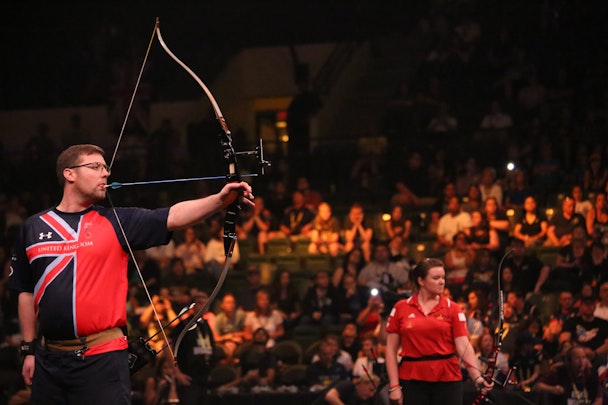Why disability representation matters for brands
Martyn Sibley is a marketer, writer and entrepreneur who was recently voted one the UK’s most influential disabled people. He’s the co-founder and chief executive officer of specialist disability marketing agency (and The Drum Network member) Purple Goat. Here, for our Deep Dive on Marketing and the Marginalized, he looks into the value of representation, for both disabled people and brands.

Martyn Sibley on representation for disabled people, and the value it can have for brands / Audi Nissen via Unsplash
When I was growing up I struggled to find people ‘just like me’ in the media and in everyday life. Being born with spinal muscular atrophy type 2 meant that I’d always need a wheelchair to move around, a care team for physical needs and a raft of other considerations to live a fulfilled life.
Fortunately, I found a way to access the right funding, equipment and care. Now I indeed do live a life of adventure. But I look back on this distinct lack of role models as an issue unto itself.
The reasons that role models matter vary from person to person. But some are pretty universal. For me, seeing someone else in a wheelchair made me feel less different. Particularly if that person was on TV, was known for doing something awesome or was even just looking content with life. It would give me such hope that despite my challenges, everything would work out fine when I grew up.
What makes a disability?
The challenges I and many of the 1.3 billion disabled people in the world face come from societal barriers. As a wheelchair user I have a medical condition that I have to manage health-wise and social care-wise.
But I’m only really ‘disabled’ by steps/stairs, prejudicial attitudes and discriminating policies. If we designed the environment, education system and societal institutions for everybody, I wouldn’t face so many of these daily social barriers that I currently do.
Two disability narratives
Even with very low (almost non-existent) representation of disability in mainstream media, another issue is the tropes we see. It’s always been either ‘triumph over tragedy’ or ‘charity and welfare.’
Both are some disabled people’s truth, and I’m not suggesting we stop sharing this narrative completely. But there’s never been a middle ground. Where is the disabled doctor, who is a loving wife and mother, and loves a summer holiday in the Canaries?
But then social media came along. Suddenly disabled people had a voice. We could shape our own storytelling. Disabled role models were suddenly everywhere. Beautiful fashion Instagrammers, intelligent activist bloggers, engaging makeup-tutoring YouTubers. All with disabilities. All around the world. Educating, entertaining and, most of all, just being their true authentic selves.
Finally, we had disabled role models to inspire the next generation, showing disabled and non-disabled children alike what a fully inclusive world might look like.
The purple pound
Unfortunately, brands haven’t yet grasped the business case and opportunities with disabled people. The 1.3 billion-strong global disability community equates to an $8tn annual market. Yet brands continue to ignore disabled people’s needs and wants, leaving important voices out of the conversation.
What if brands understood the value of disabled people? Obviously, they should recognize the moral and even legislative reasons for disability inclusion. But what if brands gauged insights, trained staff, employed disabled people, innovated accessible products and services, and had disabled voices in their marketing? The answer is in the purple pound.
The color purple was first associated with disabled people in the late 2000s during anti-government austerity cuts that affected disabled people most. The movement used purple on its website, banners and marches. Over the course of nearly a decade, the business case of disability inclusion took hold. This $8tn market, or £270bn annual household spending power in the UK, helped coin the purple pound as the carrot, the reward, the spoils of being truly inclusive to the disability community.
The time is now
With social media, influencer marketing and entrepreneurship empowering people and businesses more than ever, change is now truly possible. I started blogging in 2009 and later co-founded an accessible travel site Accomable with my childhood friend Srin Madipalli (after we started online publication Disability Horizons), which was later acquired by Airbnb.
I’m now disrupting again but with all brands, particularly through marketing and advertising, with my latest venture Purple Goat. Even with the rise of influencer marketing, only 0.06% of advertising represents disabled stories. Something needs doing.
Since starting in April 2020, we’ve worked with global tier 1 brands including Tesco, Facebook and Virgin Media/O2, activating phenomenal disabled influencers and giving the world an authentic and genuine narrative of disability through marketing media channels.
As brands begin to see the true value of disability (and the broader diversity and inclusion agenda), we’ll see a better bottom line for businesses and a better world for all. Representation is the key ingredient in empowering disabled people to get societal barriers removed, and in helping brands have a competitive advantage on an emerging market with huge growth potential. It’s a win-win.
Content by The Drum Network member:

The Goat Agency
We’re the leading global social media marketing agency powered by influencers. We pride ourselves in bringing together data-led performance, real human relationships,...
Find out more
